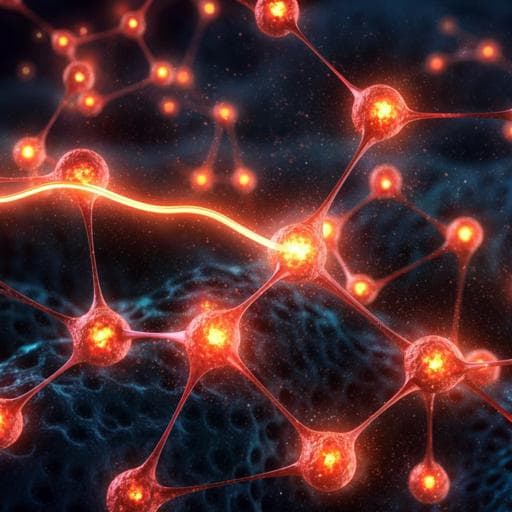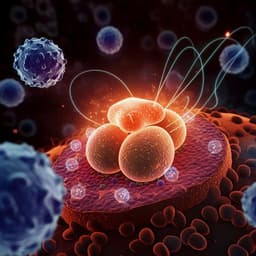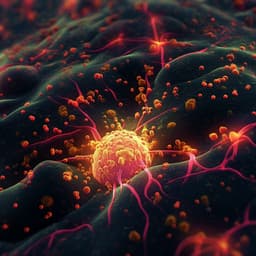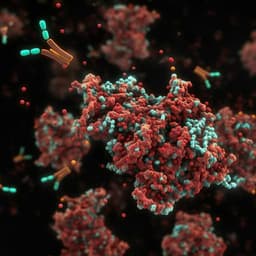
Medicine and Health
Locoregional delivery of IL-13Rx2-targeting CAR-T cells in recurrent high-grade glioma: a phase 1 trial
C. E. Brown, J. C. Hibbard, et al.
This groundbreaking phase I trial evaluated the effectiveness of IL-13Rx2-targeted CAR-T cells in 65 patients suffering from recurrent high-grade glioma. The study revealed that locoregional CAR-T cell administration was both feasible and well-tolerated, achieving stable disease or better in 50% of patients. Notably, median overall survival improved significantly based on treatment variations. This promising research was conducted by a team of dedicated researchers at City of Hope.
~3 min • Beginner • English
Introduction
Diffuse high-grade glioma (HGG), including glioblastoma (GBM; IDH-wildtype WHO grade 4 astrocytoma), has poor prognosis despite standard-of-care surgery, radiation and chemotherapy, with recurrence being inevitable. CAR-T therapy is being explored for HGG targeting antigens such as IL-13Rα2, HER2, EGFRvIII, GD2 and B7H3, with subsets of patients showing quality-of-life improvements, objective responses and notable survival benefits. IL-13Rα2 is highly expressed in most HGGs, associated with mesenchymal signatures and poor prognosis, and is absent in normal brain. The authors optimized an IL-13 cytokine-directed CAR (E12Y; 4-1BB costimulation) favoring IL-13Rα2 over IL-13Rα1. Building on prior case reports of complete response after locoregional IL-13Rα2-CAR-T delivery in multifocal rGBM, this phase I trial aimed to evaluate safety, feasibility, dose, administration routes and correlates of response for IL-13Rα2-targeted CAR-T cells in recurrent HGG.
Literature Review
Early-stage clinical trials of CAR-T in gliomas targeting IL-13Rα2, HER2, EGFRvIII, GD2 and B7H3 have demonstrated feasibility and safety, with subsets achieving improved QOL, objective responses and survival benefits. A notable prior case from the authors showed a complete response to locoregionally delivered IL-13Rα2-CAR-T cells in multifocal rGBM. IL-13Rα2 is a cancer-testis antigen broadly expressed in HGG and correlates with mesenchymal signatures and poor prognosis while absent in normal brain tissue, supporting its suitability as a CAR target. Preclinical data suggested ICV delivery may be advantageous for multifocal disease, and dual delivery (ICT plus ICV) may combine benefits of each route. Emerging evidence in hematologic malignancies indicates that less-differentiated memory T-cell phenotypes (Tn/mem) in CAR-T products are associated with superior potency and persistence compared with Tcm-derived products.
Methodology
Design and setting: Single-center, nonrandomized, five-arm, dose-escalation phase I study (NCT02208362) at City of Hope (June 2015–February 2020) assessing memory-enriched IL-13Rα2-targeted CAR-T cells in recurrent high-grade glioma (rHGG). Primary objectives: feasibility, safety, and determination of maximum tolerated dose (MTD)/maximum feasible dose (MFD) and a recommended phase 2 dosing plan (RP2D). Secondary objectives: disease response, overall survival (OS), QOL change, cytokine dynamics, CAR-T persistence/trafficking, and tumor immune contexture biomarkers.
Participants: Heavily pretreated rHGG patients (grades 3–4), including majority IDH-wildtype rGBM. Key inclusion: IL-13Rα2+ tumor by IHC, KPS ≥60, life expectancy >4 weeks; later age range expanded to 12–75 years. Key exclusion included uncontrolled comorbidities, active infections, severe organ dysfunction, etc. No restrictions on tumor size, multifocality, prior bevacizumab, or number of recurrences.
Arms and interventions: Five arms assessed three delivery routes and two manufacturing platforms: Arm 1 (ICT after biopsy; Tcm product), Arm 2 (ICT after resection; Tcm), Arm 3 (ICV; Tcm), Arm 4 (dual ICT/ICV; Tcm), Arm 5 (dual ICT/ICV; Tn/mem). Protocol amendments added ICV and dual-delivery arms and transitioned to Tn/mem platform based on clinical and preclinical rationale and manufacturing feasibility. CAR-T cells were delivered via Rickham catheters placed ICT and/or ICV depending on arm. No lymphodepleting chemotherapy was given.
Dosing and schedules: Three weekly infusions per initial treatment period (DLT window), with 3+3 dose escalation per arm. Dose schedules (per cycle, CAR+ cells ×10^6): DS1=2,10,10; DS2=10,50,50; DS3=20,100,100. In dual-delivery arms, the indicated dose was infused at each site. Additional infusions could continue weekly at ≤ highest tolerated dose contingent on eligibility and product availability. Patients progressing on arms 1–2 could optionally receive further ICV infusions.
Manufacturing: Two GMP platforms enriched less-differentiated T cells using CliniMACS selection. Tcm products: CD62L+, CD45RA− central memory enriched; Tn/mem products: CD62L+ enriched naive, stem cell memory and central memory subsets. Cells were activated with CD3/CD28 Dynabeads, transduced with a SIN lentiviral vector encoding an IL-13(E12Y)-based CAR with IgG4-Fc (L235E;N297Q) spacer, CD4 transmembrane, 4-1BB and CD3ζ signaling domains, followed by T2A-linked truncated human CD19 (CD19t) for tracking. Culture with IL-2 and IL-15; QC included viability, identity, CD19t expression, WPRE copy number, RCL testing, residual beads, and sterility.
Assessments: Safety was graded with CTCAE v4.0, CRS and modified neurotoxicity scales; DLTs prespecified. Imaging with MRI (RANO-modified criteria) and FDG-PET at baseline and serially. QOL assessed with EORTC QLQ-C30 summary scores. CAR-T persistence measured by flow cytometry in CSF and tumor cavity fluid (TCF) and by WPRE qPCR in blood. Cytokine profiling (30-plex Luminex) in CSF, TCF, and serum across cycles/timepoints (pre- and post-infusion). Tumor biomarkers included IL-13Rα2 H-score and CD3 IHC (qualitative 1–4 scale); multiplex IHC for CD8 and FOXP3 subsets. Exploratory analyses included scRNA-seq and CITE-seq profiling of 62 CAR-T products to compare Tcm vs Tn/mem product phenotypes.
Analysis: Kaplan–Meier for OS; log-rank/Harrington–Fleming tests; ANOVA and t-tests for group comparisons; propensity-weighted log-rank adjusting for pre-CAR-T tumor volume in survival comparisons between arms; linear regression models for associations (e.g., IFNγ pathway with outcomes; CD3 score and product type with log survival time). Patients evaluable for response/survival received all three initial doses.
Key Findings
Enrollment and feasibility: 92 enrolled; CAR-T successfully manufactured for 89/92 (97%; all failures in Tcm platform). Due to rapid progression, 24 did not receive infusion; 65 treated; 58 evaluable for response; 57 for OS.
Safety: No dose-limiting toxicities in any arm or dose schedule; MTD not reached. Grade ≥3 toxicities with possible or higher attribution occurred in 35% overall (Tcm arms 1–4: 17/43, 40%; Tn/mem arm 5: 6/22, 27%). Probable treatment-related events included grade 3 encephalopathy (arm 4) and grade 3 ataxia (arm 5). Two cases of transient grade 4 cerebral edema shortly after cycle 1 in patients with extensive tumor burden (managed with high-dose dexamethasone; further on-protocol infusions halted). Surgical/catheter-related grade ≥3 events included infections and wound complications. Locoregional delivery across ICT, ICV, and dual routes and doses 2–200×10^6 CAR+ T cells was generally well tolerated. A clinical MFD of 200×10^6 CAR-T cells per infusion cycle was achieved in arm 5; other arms did not test or could not achieve this due to manufacturing limits.
Efficacy: Among 58 evaluable for response, 29/58 (50%) achieved stable disease (SD) or better (duration 51 to >1,316 days); 13/58 (22%) had confirmed SD or better for ≥90 days (8 of these were grade 4 rHGG). Objective responses on protocol: 2 partial responses (UPN165, UPN180) and 1 complete response (UPN265); all three were IDH-mutant and two were grade 3. An additional CR in rGBM (IDH-wildtype) occurred off protocol with continued ICV CAR-T (UPN109) without other therapy. Median OS: all patients 8.0 months (95% CI 6.2–10.1); rGBM subset 7.7 months (6.0–10.1). Arm 5 (dual ICT/ICV; Tn/mem) achieved longest OS: all patients 10.2 months (7.5–19.9). In rGBM, arm 5 OS 10.2 months (7.7, NA) vs arms 1–4 OS 6.1 months (4.8–9.5), P=0.02; survival benefit remained significant after adjusting for pre-CAR-T tumor volume (P=0.024). QOL slopes improved modestly but significantly in rGBM on arm 5 vs arms 1–4 (P=0.027).
Product comparisons: Tn/mem platform had 100% manufacturing feasibility (33/33) and generated larger CAR-T yields. Tn/mem-derived products showed more favorable phenotype (balanced CD4/CD8; higher CD27, CD62L, CCR7; lower CD57); scRNA-seq revealed enrichment of memory-like signatures and lower dysfunctional signatures vs Tcm products. Functional assays showed superior proliferation and killing at high tumor:effector ratios; mouse models corroborated improved antitumor activity for Tn/mem-derived CAR-T cells.
Persistence and trafficking: CAR-T cells were detectable in CSF and TCF post-infusion (often at day 1 and in some cases ≥7 days), with modest dose dependence in CSF but no arm-specific differences. CAR-T cells were detected in peripheral blood, highest with dual delivery and arm 5; blood levels correlated positively with product CD27 and LAG-3 and negatively with PD-1 and CD57.
Cytokine dynamics: Robust, infusion-dependent spikes of inflammatory cytokines in CSF/TCF, especially IFNγ-pathway chemokines (IFNγ, CXCL9, CXCL10), which remained elevated up to 7+ days post-infusion. Serum changes were modest and route-dependent. Arm 5 patients had significantly higher CSF IFNγ pathway induction in early cycles compared to arms 3–4. Higher CSF IFNγ pathway scores correlated with better best response category and longer time to progression.
Tumor immune contexture: Pretreatment intratumoral CD3 infiltration (intermediate/high scores 3–4 vs low 1–2) was associated with improved OS in all patients (median 11.2 vs 6.5 months; P=0.02) and in rGBM (10.3 vs 6.0 months; P=0.01). Linear regression on rGBM indicated both higher CD3 scores and Tn/mem product independently associated with longer survival; intermediate/high CD3 predicted ~2× survival benefit; in CD3-low tumors, Tn/mem predicted ~1.6× benefit over Tcm.
Discussion
This largest-to-date CAR-T brain tumor trial demonstrates that repetitive locoregional administration of IL-13Rα2-targeted CAR-T cells is feasible and safe without DLTs across ICT, ICV, and dual routes. Clinical activity included prolonged SD and occasional radiographic responses, with arm 5 (dual ICT/ICV using Tn/mem-derived products) showing the most favorable OS and QOL trends, despite the nonrandomized design and similar baseline characteristics between groups. The Tn/mem platform improved manufacturing feasibility, product homogeneity, less-differentiated memory phenotype, and peripheral persistence, consistent with hematologic malignancy experience. CAR-T cells delivered to the CNS trafficked to blood without notable systemic toxicity, suggesting potential systemic immune engagement. Treatment induced CNS-restricted inflammatory cytokine surges, particularly IFNγ, CXCL9, and CXCL10; arm 5 exhibited the greatest IFNγ-pathway induction, and higher CSF IFNγ pathway scores correlated with better outcomes, suggesting a potential biomarker of CAR-T bioactivity. Importantly, pretreatment tumor T-cell infiltration (CD3) correlated with survival benefit, indicating the tumor immune contexture is a key determinant of CAR-T responsiveness in solid tumors like GBM. Together, both product fitness (Tn/mem) and a ‘hot’ TME (higher CD3) independently contributed to improved outcomes. These findings inform optimization of CAR-T product composition and delivery strategies and support development of biomarkers (e.g., CSF IFNγ signature, CD3 infiltrates) for patient selection and on-treatment monitoring.
Conclusion
Locoregional IL-13Rα2-CAR-T therapy for recurrent HGG is safe and feasible, achieving a clinical MFD of 200×10^6 CAR+ T cells per cycle without DLTs and demonstrating antitumor activity with durable disease control in a subset. Dual ICT/ICV delivery combined with Tn/mem-derived products (arm 5) yielded the longest survival and improved QOL trends, with robust CNS cytokine activation and peripheral trafficking. CSF IFNγ-pathway cytokines emerged as candidate pharmacodynamic biomarkers of CAR-T activity, and higher pretreatment intratumoral CD3+ T-cell infiltration correlated with improved survival, underscoring the importance of tumor immune contexture. Future work will refine RP2D based on these data, further evaluate mechanisms and biomarkers (including potential on-target, off-tumor assessments such as testosterone in males), and validate dual-delivery and Tn/mem manufacturing in ongoing phase I/II studies (e.g., NCT04003649, NCT04510051, NCT04661384). Prospective, randomized, multi-center trials with integrated biomarker strategies are warranted to confirm efficacy, optimize dosing and delivery, and define patient selection criteria.
Limitations
Key limitations include the single-center, nonrandomized design with multiple arms and dose schedules, complicating correlative comparisons and introducing potential selection biases. Arm-level imbalances (e.g., smaller pre-CAR-T tumor volumes and less prior bevacizumab in arm 5) may confound outcome comparisons, although survival benefits persisted after adjusting for tumor volume; limited sample size precluded adjustment for prior bevacizumab. The study was not powered for definitive efficacy; some analyses were exploratory and post hoc without multiple-testing correction. Heterogeneity in disease stage, histology, and prior treatments may affect generalizability. Follow-up allowed additional off-protocol CAR-T infusions in some patients, potentially influencing outcomes. Biomarker analyses were constrained by sample availability and timing.
Related Publications
Explore these studies to deepen your understanding of the subject.







